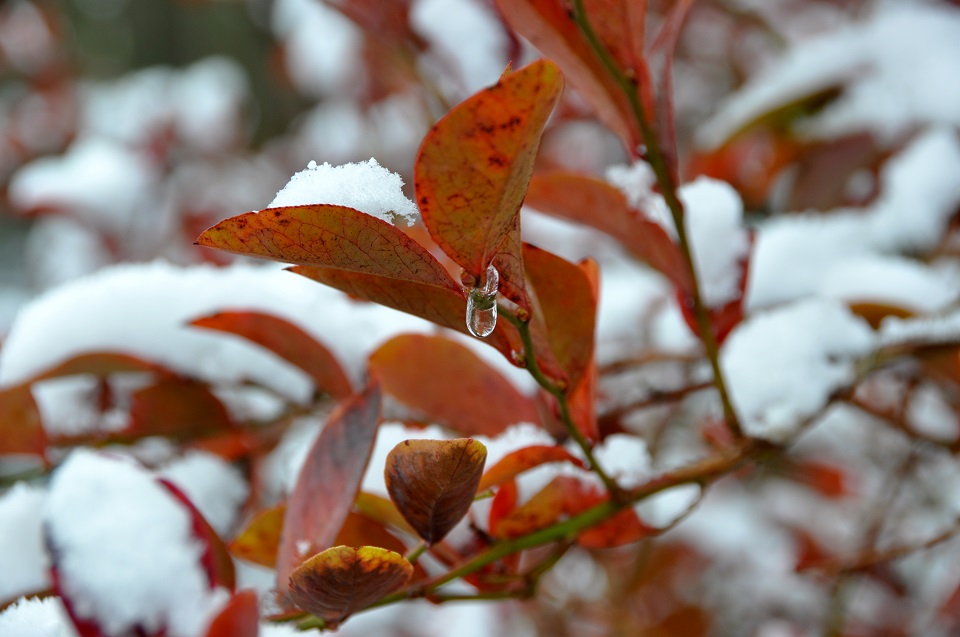
Submitted by Andy Pulte, UT Department of Plant Sciences
When thinking about blueberries (Vaccinium spp.), the mind often goes first to a favorite dessert or eating fresh berries from a farmers market stand. However, blueberries bring a unique combination of a beloved fruit, plus remarkable ornamental beauty. Blueberries, though underused in the landscape, are fairly easy to grow and are historically known as plants seldom bothered by pests.
Vaccinium is a relatively large genus of plants with representative species in several parts of the world. They range from what we often refer to as a blueberry to the tart cranberry. Americans in general are in love with the blue fruits that are likely to show up in a pancake or muffin. In fact Americans now consume three times more fresh blueberries than they did 10 years ago. Interest has been sparked, in part, because blueberries are packed with antioxidants, are low in calories and rich in vitamin C. The USDA (United States Department of Agriculture) and its partners are currently looking at blueberries for their potentially positive impacts on cardiovascular health, strong bone formation and prevention of breast cancer.
However, focusing solely on the fruit is a mistake for the home gardener. Blueberries have beautiful, often powdery blue foliage. In many locations, its foliage is nearly semi-evergreen, sometimes persisting into late November and December. In milder years, and depending on the variety, foliage can remain into the new year. When foliage becomes sparse, beautiful, often red-hued, stiff stems and branches are revealed. This can add both color and interest to the winter garden.
When choosing a blueberry, make sure to choose one that is suited to your area. Recommendations may vary depending on your specific locations and growing conditions. Many different hybrids exist which can add confusion. Varieties of blueberries are distinguished by their suitability to specific climates and their ripening season. Many blueberry varieties are best paired with another similar variety to maximize fruit set. While it is possible to have only one blueberry plant and get fruit (look for varieties that are promoted as being highly self-fertile), you will not get as many berries. Before buying one or several blueberry bushes, do your research, talk to other gardeners or your county extension office. Look for different varieties that bloom at the same time for cross-pollination. Adding groupings of blueberries with fruit that ripen at different times is a way to extend the harvest for the home gardener.
Blueberries thrive in acidic soil in sunny locations. When planting blueberries, the American Blueberry Council recommends working up a planting area approximately 2-1/2 feet in diameter and one foot deep. Remove one third to one half of the soil, and then add an equal amount of pre-moistened peat moss to the hole and mix well. If gardening in raised beds, mix equal parts peat moss with compost or planting mix and garden soil.
There is no general recommendation for spacing of blueberries; many varieties can be spaced relatively close together to form a tight hedgerow. However, try to allow adequate air circulation and leave room to pick fruit when they ripen in summer. Always plan for a plant’s ultimate mature height and width. Mulch your blueberries with a 3-inch layer of pine needles, bark mulch or even weed-free grass clippings. This will allow for good moisture conservation during the growing season.
Your first couple of years growing blueberries, you are going to feel like a child who has been told they can eat one marshmallow now, or twenty if you can wait for an hour. When adding new blueberries, it is important to give your plants time to establish. This is aided by removing all, (yes, ALL) the blooms for two springs in a row. You will harvest more fruit over a five-year period when you make this early sacrifice. So be patient now, and enjoy more fruit later.
Blueberries have been historically pest free. It is often rated as the fruit you can grow with the least amount of inputs like chemical sprays. However, a new threat has emerged for both our home and commercially grown blueberries. The spotted wing drosophila (SWD) is an invasive pest of small fruits that has become established in Tennessee and the Mid-South. The fly lays eggs in fruits and the resulting maggot infestation causes premature fruit drop that renders the crop unsuitable for human consumption. Both conventional and organic methods are currently being studied to determine how to best control this pest. Look for reliable sources like university extension programs to keep up-to-date on control and other recommendations.
University of Tennessee Extension has a free publication for home gardeners interested in blueberries. Search for UT Extension Publication SP284-D online at http://utextension.tennessee.edu/publications. There are two main types of blueberry plants grown by home gardeners, rabbiteye and highbush. Rabbiteye are native to the southern United States, and are the most widely recommended for Tennessee gardens because they survive better in drier, warmer temperatures than highbush types. Rabbiteyes can be grown without irrigation, but a mulch for moisture control is necessary. Many new hybrid varieties have also entered the market and are currently being evaluated at the UT Gardens.
Andy Pulte is a member of the faculty of the UT Institute of Agriculture Department of Plant Science. He teaches basic landscape plants, among other courses.The UT Gardens includes plant collections located in Knoxville, Jackson and Crossville. Designated as the official botanical garden for the State of Tennessee, the collections are part of the UT Institute of Agriculture. The gardens’ mission is to foster appreciation, education and stewardship of plants through garden displays, educational programs and research trials. The gardens are open during all seasons and free to the public. For more information see http://utgardens.tennessee.edu.
Contact:
Andy Pulte, UT Department of Plant Sciences